75 YEARS OF AMERICAN INGENUITY
THE GRADALL LEGEND
A history of the evolution of an American icon in the construction industry.
INTRO
Gradall Product History
The history of Gradall as a company and as a product can be traced to two brothers, Ray and Koop Ferwerda, who emigrated from Holland to Cleveland, Ohio, in 1920. They immediately found work with construction of commercial and residential building projects in northeast Ohio, and by 1925, they started the Ferwerda Brothers Construction Co., involved in the building of roads and bridges, installing water and sewer lines, and building site preparation.
With their work with road construction, they were challenged -- like all contractors -- with the use of hand labor using shovels, rakes and pikes to finish grade roadside embankments. In the late 1930s factories, were hiring men for military armament production to support the U.S. allies in Europe and China. This led to fewer men available to work in construction and especially to perform roadside finish grading work.
This situation led the Ferwerda brothers to use their ingenuity to design a machine to do this type of work more efficiently. That machine was the Gradall®.
In November 1941, Ray and Koop sold a portion of their equipment to rent a garage in Beachwood, Ohio, and buy equipment to make their grading machine. The brothers asked two Cleveland contractors who they worked for to be partners in the making of the grading machine.
Those contractors were Ralph Werba of Werba & Long Construction Co. and Donald Finlay of Donald Finlay & Sons Construction Co. With the assistance of their partners, the brothers formed a manufacturing company called the FWF Corp. (Ferwerda, Werba and Finlay). With the necessary money in the bank, the brothers went to work.
1944
The First Gradall Excavator
In the spring of 1944, the first Gradall machine rolled out of Ferwerda’s garage and dug a trench as well as sizable hole in the ground. This new machine had a hydraulically powered telescopic boom that could be raised and lowered and tilted left or right.
There was an excavating bucket mounted on the end of the telescopic boom with two strong steel hinge-pins for wrist-action. The bucket was operated by a hydraulic cylinder that gave the bucket the powerful wrist-action to grade a slope, dig a hole and load a truck.
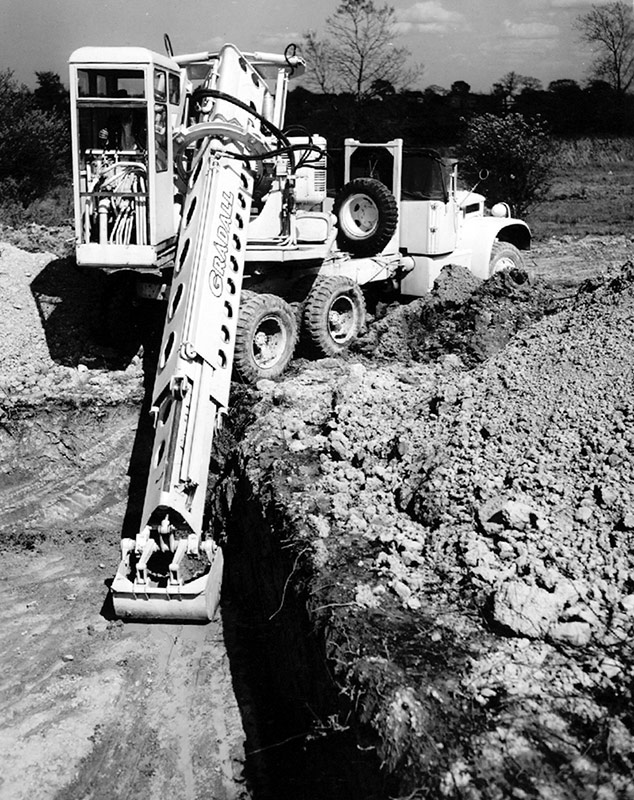
This situation led the Ferwerda brothers to use their ingenuity to design a machine to do this type of work more efficiently. That machine was the Gradall®.
By the fall of 1945, the FWF Corp. had built five Gradall machines. Two were prototypes for test purposes and the other three were production machines available for sale. The machines were used on construction jobs throughout northeast Ohio and demonstrated to city officials to show the machine’s versatility for street maintenance, trenching and snow removal.
In November 1945, the Warner & Swasey Co. of Cleveland made an agreement with the Ferwerda brothers to acquire the rights to use their Gradall patents to manufacture and market the Gradall. Warner & Swasey would make the Gradall a successful business operation.
1946
M-2400 Model Is Introduced
In January 1946 manufacturing of the first Gradall Model M-2400 was setup in the W&S machine tool plant complex in Cleveland, and by the end of that year, Lot 1 of the first 11 Gradall M-2400 machines was shipped from Cleveland manufacturing operations.
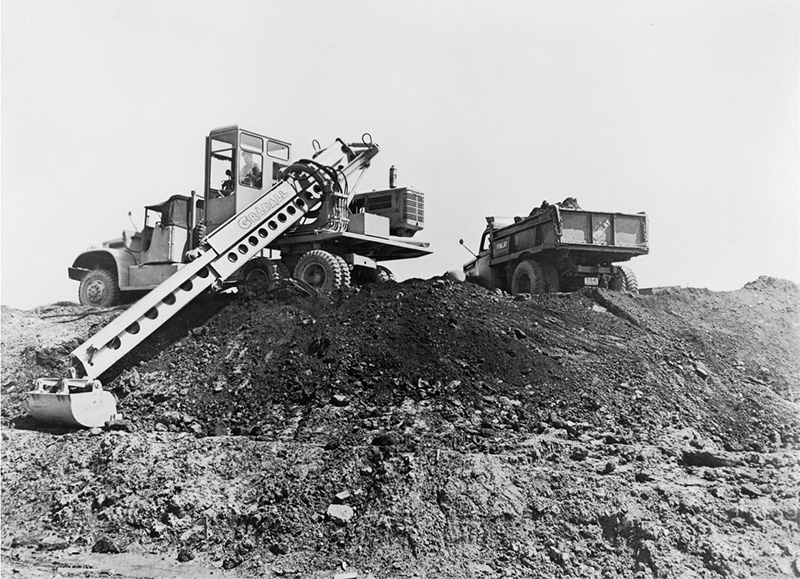
At the 1948 Road Show in Chicago, the Gradall M-2400 was introduced to the construction industry. The industry media review of the show ranked the M-2400 as one of the top five machines on display. As a “hydraulic excavator,” they recognized the M-2400 with unmatched hydraulic operation for digging and grading.
This situation led the Ferwerda brothers to use their ingenuity to design a machine to do this type of work more efficiently. That machine was the Gradall®.
By the close of 1948, the Gradall engineering team completed the design of the new Model M-2460. This Gradall model had an improved boom design with the boom hoist cylinders mounted to the front of the boom cradle, increasing the lift capacity of the boom.
This new model also had a new operator’s cab with the machine’s control valves moved from the inside of the operator’s cab to a position behind the cab in the machine’s structural framework. This change improved operator visibility and eliminated the uncomfortable heat in the cab from the hydraulic control valves.
1950
Gradall Moves to New Philadelphia, Ohio
This new model also had a new operator’s cab with the machine’s control valves moved from the inside of the operator’s cab to a position behind the cab in the machine’s structural framework. This change improved operator visibility and eliminated the uncomfortable heat in the cab from the hydraulic control valves.
The 1951 monthly Gradall production plan called for 20 excavators to be built per month. This was 100 percent more than the machine production at the W&S plant in Cleveland.
At the Industry Road Show in Chicago in January 1953, the Gradall Division exhibited four different models of the M-2460: the truck-mount, the truck-mount with railroad guide wheels, the crawler-mount and the wagon-mount.
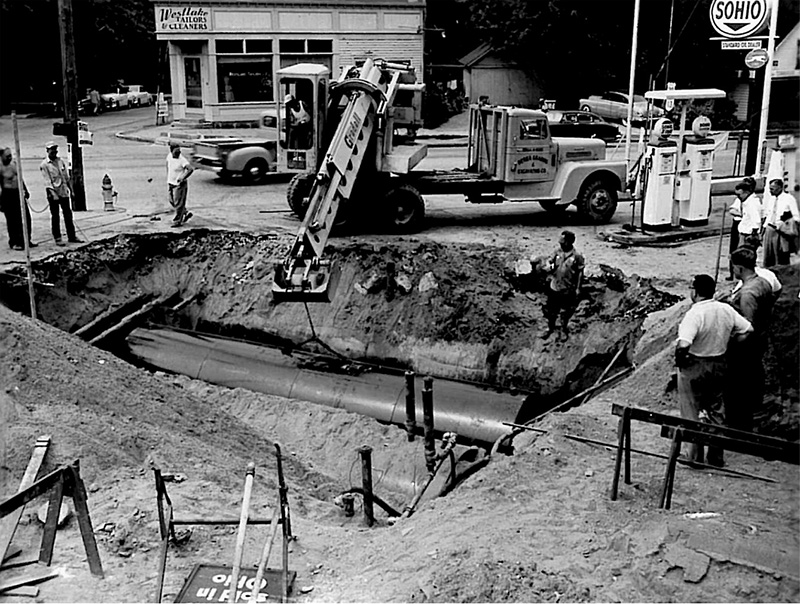
The new crawler undercarriage allowed the Gradall to operate in work areas where heavier tracked type construction equipment could not maneuver. The new wagon-mounted model was mounted on a two-axle self-propelled carrier. This unit was designed for yard material handling and roadway maintenance with municipalities.
With the use of the Gradall machine’s strong telescopic boom, steel mill maintenance work became a new type of work for these machines. The M-2460 crawler model was ideal for working in the crowded areas of a steel mill. This machine’s size and telescopic boom action permitted it to work in the most confining locations for furnace access.
Before the introduction of the Gradall, the steel industry did not have powered equipment to perform this type of mill maintenance work.
1958
New Model Era Begins
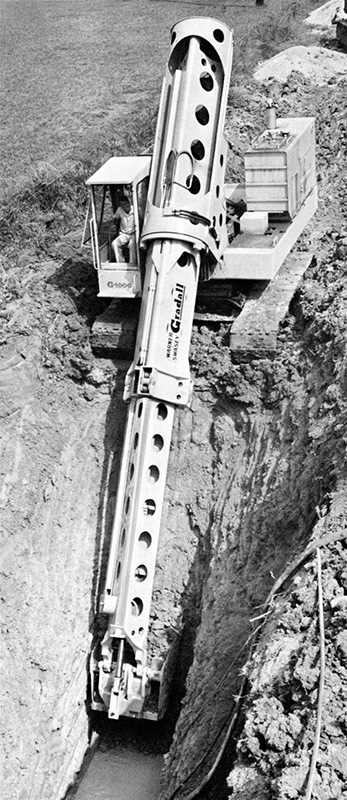
In 1956, the Gradall product planning team was exploring the market requirements for the next model Gradall. The information coming to the division from its distributors and end-user customers was that there was a need for a larger Gradall machine.
The sales and engineering staff also recognized this need and began to develop a machine more powerful than the M-2460 for heavy production work in land clearing, site preparation and finish grading for commercial and highway construction. The next Gradall was designed to have the precision and versatility of the M-2460. But it would also have greater hydraulic power, longer boom reach and larger bucket capacity in excess of one cubic yard.
Warner & Swasey made a major announcement to the construction equipment industry in September 1958, introducing the G-1000 – the largest production hydraulic excavator in the industry. The capacity of the standard G-1000 excavating bucket was 1-1/4 yards and the machine could lift as much as 14,000-pounds.
The introductions was very successful, meeting the need for productive machines to build the nation's interstate system.
A key innovation with the G-1000 and future models was “fast change attachments.” Attachments for this machine could be removed and attached in a matter of seconds using only two large locking bolts with nuts that had to be loosened and tightened.
The Model G-600, a replacement for the M-2460, was introduced in 1962. This new model had several important design changes that improved machine productivity and operator comfort. A very important machine option available with the G-600 was hydraulic remote control of the truck chassis.
The G-800 introduced in 1967 had a very valuable design improvement that set a standard for the boom and cradle assembly design of future Gradall models. The G-800 boom and cradle assembly was designed whereby the machine could dig vertically with the boom straight down into an excavation. The maximum digging depth of this new machine was 23 feet; while the G-1000 was 18 feet and the G-600 was 11 feet. This model was the first excavator to use a Gradall-designed hydraulic-powered crawler undercarriage.
1968
G-660 Is Introduced

In September 1968, the Gradall model G-660 was introduced. The design features of this excavator utilized many of the proven design features of the Model G-800. This model had vertical dig and the remote control of the truck carrier as a standard option. It also featured a boom design that provided for the fast change of attachments that was originally offered with the G-1000. This G-660 was the new core model for the product line following the success of the M-2460 and G-600.
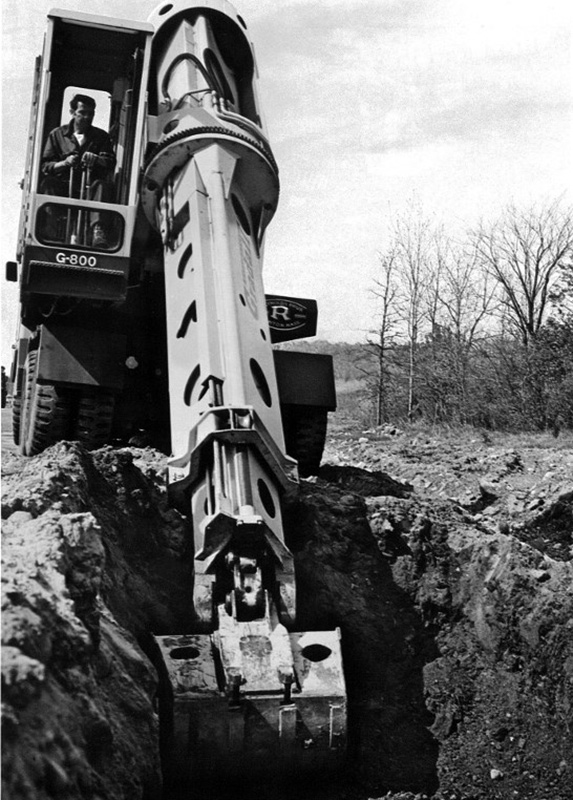
The G-800 and G-1000 gave customers power and productivity not matched by the other competitive manufacturers of telescopic boom hydraulic excavators. And the growing versatility of job applications for the various Gradall models gave the product line a wider market than other manufacturers of hydraulic excavators.
The Model G-880 was introduced in 1972. It was a productive hydraulic excavator that gained much favor for industrial maintenance and underground mining. This machine was the platform for industrial work with special industrial design options for steel mill maintenance or scaling operations in underground mining.

The Model G-880SI would become the global standard for steel mill maintenance work. To better support and carry the crawler model G-660 with greater mobility, a new tractor-type crawler undercarriage was developed for introduction with the new G-880.
In April 1975, the Gradall Division introduced the Model G-440 with all the features of the proven G-660. The G-440 was designed primarily for the municipal service and small contractor markets.
1980
Progress In Spite of Ownership Changes
Within the first five years of the 1980s, the Gradall Division had four different owners. None of these owners included the Warner & Swasey Co., which became a business unit of Bendix Corporation as a result of a 1979 merger.
The dynamics of operating with four different owners would seem never-ending with continuous challenges for both the Gradall management team as well as the entire workforce.

In 1980, the Gradall Division would introduce a new family of 30,000-pound excavators replacing the G-440 model. The new model series was given the designation of “G3 Series.”
During 1981, product improvements were introduced with the G-660 and G-880 models. Increased hydraulic power for the G-660 model was introduced with the new V-HP system.
This new high-pressure hydraulic system introduced on the G-660B at ConExpo 1981 was offered as a machine option. V-HP would become standard on the G-660C and G-880C model excavators. V-HP stands for “Variable Flow High Pressure.
1985
G3WD Debuts Single-Engine Concept
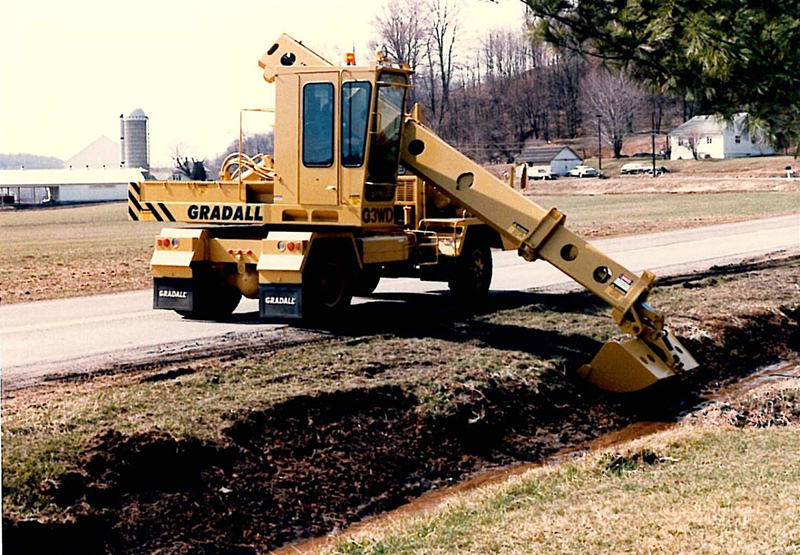
In April 1985, the new single engine G3WD Gradall excavator was introduced. This new machine was 30 percent more productive and 30 percent less expensive to maintain. The G3WD was the first Gradall single engine excavator mounted on a chassis with two axles — not the traditional three-axle chassis for the other Gradall highway speed models.
The single engine G3WD would be a product design that would impact the design of future Gradall truck-mounted excavator models. With the start of the single engine design of the G3WD, by the year 2007, all Gradall truck-mounted excavators would be powered only by the chassis engine.
The new G-660E unveiled the most powerful Model G-660 built, carried on a new truck chassis design that could accommodate large engines. The excavator controls consisted of two joysticks with two pedals for remote control operation of the chassis.
In 1989 the G-880E was introduced. While the G-880E continued to be larger than the G-660E, the hydraulic pump and valves were the same as the G-660E. This hydraulic improvement with the “E” design would give the G-880E greater productivity. With the newly designed hydraulic system this machine would have greater hydraulic pressures to be used with its industrial models the G-880E SI and G-880E MS.
1993
XL Series Hydraulics Open New Era

The Gradall XL Series excavators and industrial maintenance machines would break out of the mold of fixed flow hydraulics systems and utilize high-pressure hydraulics. The new XL 5100 replaced the G-880E truck-mounted highway speed excavator and the new XL 5200 replaced the G880E crawler model.
These machines had high-pressure piston pumps and motors, a large operator-friendly cab with a comfortable seat, joystick controls mounted in the seat arm rests and low profile machine construction providing for full-vision operation from any location in the cab.
In 1993, the XL Series design would include the XL 4100, replacing the G-600E truck-mount model, and the XL 4200 which replaced the G-660E crawler model.
The new XL Series excavators would take on the challenge of comparable conventional hydraulic excavators by removing heavy concrete pavement, excavating large foundations and performing fine grading and exact excavating. Additional models would be added to the Gradall XL Series which would include the XL 3000 and XL 2000 series machines.
1996
Continuing Growth Over the Years
The growth of the Gradall Co. is reflected in several areas: the company’s product population and markets served; the number of active and retired employees; and the factory facilities and investment in manufacturing and engineering technology.
All of this speaks volumes to the growth and success of this company during those 50 years. It is the contribution of all the Gradall employees, regardless of their roles in this company, that have shaped this company toward what it achieved in 1996.
This same year, the Gradall Co. made its mark on Wall Street. On August 28, 1996, Gradall Industries made application with the Wall Street investment community for an initial public stock offering (IPO) and thereby became a public company.
Shortly after ConExpo 1999, on May 17, 1999, JLG Industries Inc. acquired Gradall Industries. The theme in the combining of these two companies was entitled “A Winning Team.” For all employees, according to Gradall executives Dave Black and Barry Phillips, “The accomplishment of this combination takes similar values and goals with a common vision for the future. It also takes shared customers, high-quality products and outstanding people to make it work.”
The successful G3WD-E model excavator was replaced in the year 2000 by a new XL Series model – the XL 3100. Similar to the G3WD-E that rode on two axles, the XL 3100 would have many of the advantages taken from the design of the chassis of the XL 4100 model.

Compared to the G3WD-E, the XL 3100 operator and driver's cabs were roomier and the controls were easier to use in both the chassis and the excavator. Gradall excavator machine sales were strong for that year.
2003
XL 4100 II Signals New Direction
In the year 2003, Gradall introduced the XL 4100 II. This was a totally new design for the XL 4100 chassis and excavator. This Gradall excavator model would use a single engine to operate both the truck carrier and the excavator. This design concept has been proven with the Gradall models G3WD-E and its successful replacement, the XL 3100. The XL 4100 II truck chassis was built with a more powerful engine and cooling system for the hydraulic pumps which powered the excavator.
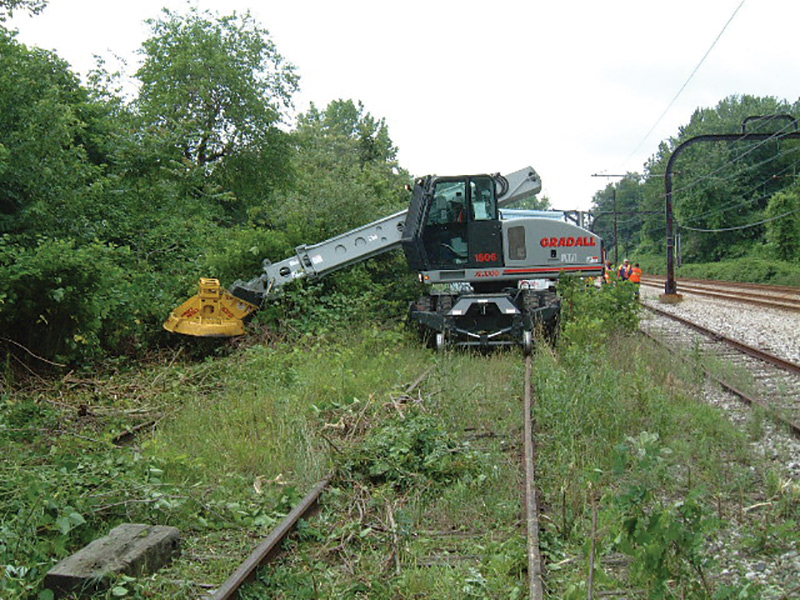
In March 2005, the new XL 3300 railroad maintenance machine model made its debut at ConExpo-CON/AGG 2005 in Las Vegas. This new version of a Gradall railroad maintenance model increased popularity with railroads and municipal transit systems for track replacement and right-of-way maintenance.
The XL 3300, unlike the truck-mounted XL 3100, could travel quickly on roadways, off-road or on rails – enabling it to be used on and off rails in very remote and rugged areas where there are no access roads to the railroad right-of-way. The four-wheel rough-terrain undercarriage allows machine mobility in any working condition when it has to leave or return to the rails.
Similar in design, two more rough-terrain rubber-tire undercarriage machines were also added to the Gradall collection – the XL 4300 and XL 5300. These machines gave contractors a choice of model sizes with all-terrain mobility options on general construction, road building and other types of job sites.
On February 3, 2006, the Alamo Group Inc., of Seguin, Texas, announced the acquisition of the assets of the Gradall excavator business including the manufacturing plant in New Philadelphia.
With the acquisition of Gradall, the Alamo Group would become an industry leader in the design and manufacturer of high-quality equipment for right-of-way maintenance and agriculture. The portfolio of Alamo Group products would include tractor and truck-mounted mowing and maintenance equipment, excavators, street sweepers, vacuum trucks, snow blowers, pothole patchers, agriculture implements and related aftermarket parts and services.
2006
Series III Brings Greater Owner Benefits
The XL 5100 III introduced in December 2006 was the third highway-speed truck-mounted excavator model powered with a single engine. Unlike the previous XL 5100 model that used two engines, the XL 5100 III was powered by a single Detroit Diesel Mercedes, Tier 3 engine.
Similar to the single engine XL 3100 II and XL 4100 II, the owner of an XL 5100 III excavator also would realize the same degree of savings in fuel and service costs. The lift capability was rated at 1,000 pounds less than the lift capacity of the G-1000, but the XL 5100 III proved to be much faster and more productive than the G-1000.

The new electronic joysticks in the three Series III highway speed models delivered greater reliability than the older hydraulic joystick control systems. A positive design change narrowed the chassis width on the three machines to 9 feet, 6 inches, meeting DOT highway standards for heavy duty trucks.
The designation of “Series III” also signified Gradall product development in excavator machine commonality. The XL 5100 III design would be a platform for common parts and component design for the other XL models that would follow with the Series III designation.
This new design concept meant that machine attachments, major fabrications and power train components would be more common with other XL Series models. For example, attachments for the XL 5100 III are interchangeable with the XL 4100 II model – a big benefit to Gradall owners.
Machine colors were a major factor in evolution of Gradall excavators. Series III models departed from the traditional yellow, introducing a grey color scheme. Series IV highway speed models marked the return to the yellow color scheme as well as introducing a 24-volt electrical system.
2015
Major New Product Introductions

At the beginning of 2015, Gradall introduced its new Discovery Series excavators, featuring an excavator upperstructure integrated into a Freightliner truck chassis. Designed to meet the common needs of states, counties and cities, the first model – D 152 – was carefully priced to meet conservative government budgets and it received a warm reception.
Also during 2015, Gradall introduced Series V excavators in both the crawler and wheeled on/off pavement model categories. These models were noted for features such as their state-of-the-art Tier 4F engines and new cabs with extra safety production.
A legendary concept that has never changed throughout the years is the Gradall hydraulic telescoping tilting boom assembly. Today, with modern hydraulic technology and improved structural design, these machines deliver greater power and digging cycle times compared with conventional boom excavators.
Growth in business continues to be dependent on the opportunities of new product development and special machine applications to meet the needs of the markets. Parallel with this growth is the endless involvement and action to improve productivity, reduce costs and maintain product quality.
With the XL Series the company has strived to go beyond the “product application niche” by designing a better product rather than just adding another product or a conventional excavator to a very competitive market. Historically, Gradall Industries has always provided a versatile product and tried to grow its market by looking at options.
In the 1960s, the Gradall crawler model grew the market. In the 1990s the Gradall XL Series grew the market. In 2015, the Discovery Series is showing signs that it again will grow the municipal market in particular.
When the company was purchased by the Alamo Group in February 2006, Gradall Industries was firmly set on a direction to continue to grow with the development of new excavator products and with the creation of new business opportunities.
Its resources in research and development, quality of plant organization and strength in its markets contributed to this growth. Gradall Industries has evolved through a set of enduring qualities that has served it well for over sixty years. This same respect must be credited to the ingenuity and work of Ray and Koop Ferwerda.
2016
Gradall's 20,000th Machine
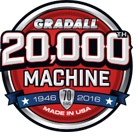
Gradall Industries rolled out its 20,000th excavator on Friday, June 24, 2016, during a celebration at its New Philadelphia headquarters that included employees, retirees, community leaders and a variety of local, state and federal government officials.
The 20,000th machine was a Discovery Series D154 model, specially wrapped in red, white and blue to signify Gradall’s association with the “I Make America” campaign organized by the Association of Equipment Manufacturers. Discovery Series models are Gradall’s newest – introduced in February 2015 and positioned as an economical solution for governments that need multi-purpose machines for ditching, grading and street repair.
Mike Haberman, president of Gradall Industries, recognized the importance of government support on every level, welcoming U.S. Rep. Bob Gibbs, State Rep. Al Landis and Mayors Joel Day of New Philadelphia and Rick Homrighausen of Dover to the dais.

“Today is an important day,” he said, “as we look back on the history of Gradall, and look forward to the next 20,000 machines manufactured here.”
Haberman said three components will allow continued growth to happen: energy independence, a focus on education and regulatory and tax reform.
“We need people who are focused on careers and living-wage jobs who can raise families,” he added. “I truly believe if you allow the American worker the ability, they will drive efficiency. They will drive quality and innovation. And those things drive jobs.”
Gradall supports over 300 jobs in New Philadelphia at its state-of-the-art manufacturing facility, where it also produces Vacall vacuum and jetting machines for sewer cleaning, hydro excavation, sweeping and industrial cleanup.
“Gradall is part of the fabric of this community,” Haberman said, noting that Gradall has a history of being a good corporate citizen while also crediting its many local alliances including the Buckeye Career Center and the Kent State Tuscarawas campus. “We’ve been here a long time, and we want to stay here a lot longer,” he noted.
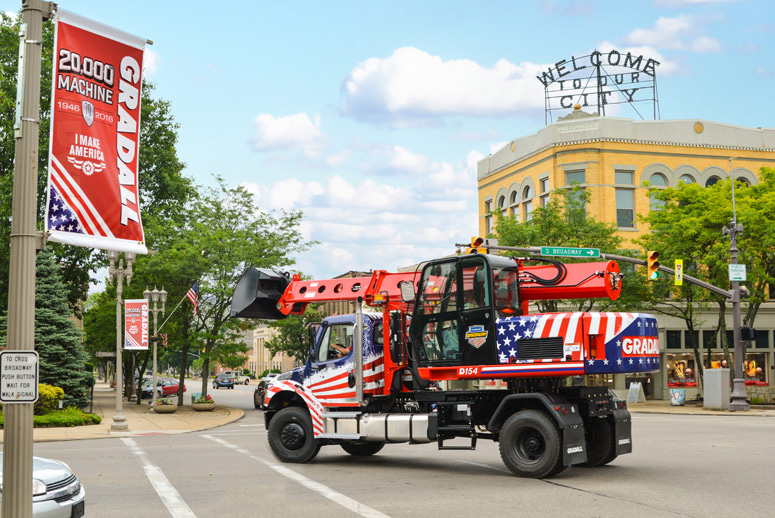
Gradall is the only manufacturer that produces excavators only in America, creating an appropriate link to the “I Make America” initiative of the Association of Equipment Manufacturers (AEM), which was represented at the event. “I Make America” highlights the manufacturing issues at stake this election season, and promotes the public policies manufacturers like Gradall need to stay globally competitive.
The 20,000th machine was sold to GS Equipment, a Gradall distributor in Florida, owned by the Ferwerda family – descendants of Ray and Koop Ferwerda, the inventors of the first Gradall prototypes in 1944. Attending Friday’s event were Ray Ferwerda Jr., grandson of Koop, and Ray’s son, Fred.
“There’s a tremendous connection there from the beginning to the end,” commented Haberman.
Keys to the machine were handed over to the Ferwerdas by Ted DeMattio, a Gradall retiree who drove the first excavator off the manufacturing floor in New Philadelphia in 1950. The excavator will remain in New Philadelphia through July for community events, then shipped to GS Equipment.